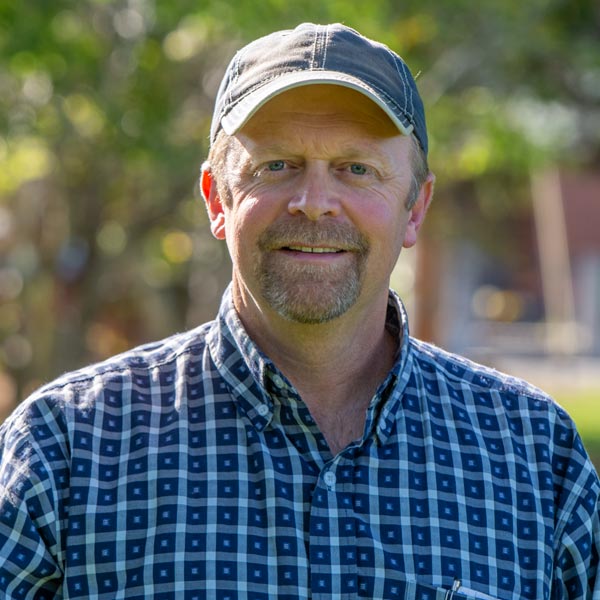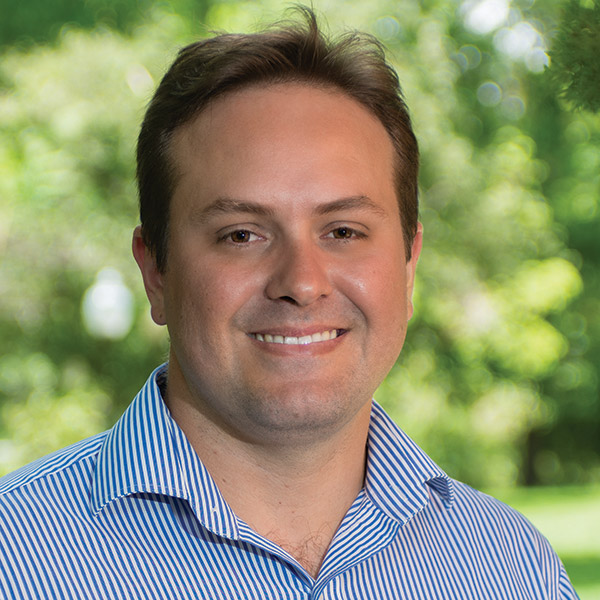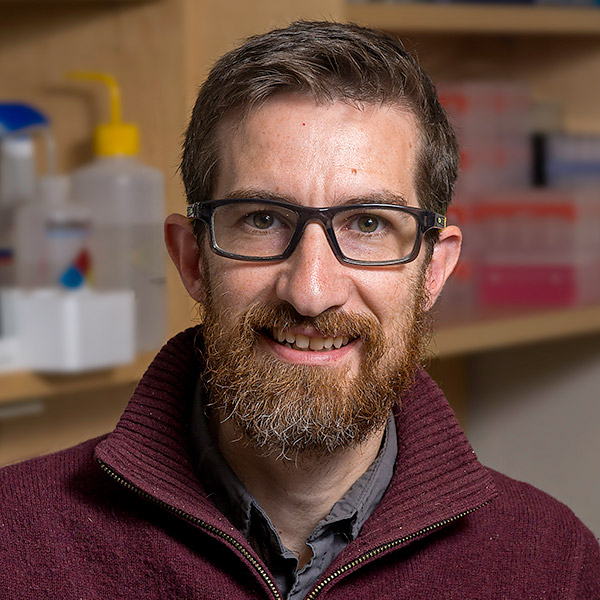Advancing agriculture technology
Researching innovative GPS technology for Nevada cattle and range management
![]() Paul Meiman and local ranchers have started researching GPS-capable collars for cattle. Photo by Paul Meiman.
Paul Meiman and local ranchers have started researching GPS-capable collars for cattle. Photo by Paul Meiman.
![]() Story by Hannah Alfaro
Story by Hannah Alfaro
Paul Meiman, associate professor and Extension specialist in the College, is leading research on virtual fencing for ranches.
When Meiman started working in Elko in fall 2019 as a specialist in rangeland livestock and wildlife interactions, he learned that local ranchers were interested in implementing virtual fencing for managing livestock. Meiman was aware of the benefits and advancements with these technologies, and he saw the opportunity to conduct valuable research on this new tool.
So, he and graduate student Nathan Jero worked with the Maggie Creek Ranch, Cottonwood Ranch and virtual fencing company Vence to install towers to communicate with GPS collars worn by the cattle. When the cattle are near the boundary dictated by the computer system, they’re signaled warnings through the collars, such as sounds and small electrical stimulation cues to keep them where they are supposed to be. The virtual fence boundaries can be placed almost anywhere and moved easily, unlike conventional fences. The cattle, about 130 at each ranch, received their collars in July 2020.
 Paul Meiman
Paul Meiman
Meiman’s research is unique in the realm of virtual fencing due to both the scale and method. So far, virtual fencing has been studied using small numbers of animals (six to 30) on small areas of land (less than 30 acres). Meiman, however, is planning on using this technology on hundreds of animals and thousands of acres. His overall goal is to find the various ways this technology can help meet the needs of ranchers and sustain our rangelands for future ranching, wildlife and other purposes.
Developing valuable tools with Nevada ranchers
"We couldn’t dream of doing this kind of work without the support and help of the ranchers. With their help, we’re hoping these virtual fencing technologies develop into a new and valuable tool for rangeland management, helping to sustain this valuable resource for the future." -Associate Professor Paul Meiman
Associate professor uses innovative technology for dryland research
![]() Robert Washington-Allen uses virtual and augmented reality technology to study Nevada dryland systems. Photo by Robert Moore.
Robert Washington-Allen uses virtual and augmented reality technology to study Nevada dryland systems. Photo by Robert Moore.
![]() Story by Hannah Alfaro
Story by Hannah Alfaro
Robert Washington-Allen joined the Department of Agriculture, Veterinary & Rangeland Sciences in fall 2019 as an associate professor, graduate program director for the department and Range Club advisor.
Along with teaching and advising, Washington-Allen researches the sustainability of drylands using innovative technologies, including drones, laser scanning, ground-penetrating radar, virtual and augmented reality tools, geographic information systems, and remote sensing. His research focuses on the past, present and future sustainability of drylands at both local and international scales, with a particular interest in Nevada’s drylands.
Washington-Allen plans to develop courses for students with an interest in drylands to train them in using these new technologies, as well as the powerful open-source software and data archives that are available to them.
Currently, he and his colleagues and students are working with the U.S. Forest Service and local ranchers to use remote-sensing technologies and targeted grazing to reduce invasive annual grass fuel loads in Nevada. He is also studying sorghum.
![]() Story by Ashley Andrews
Story by Ashley Andrews
Since sorghum is so drought tolerant, it is a sustainable option for food, feed, beer and biofuels. It's also emerging as a high-value crop for specialty markets, such as those for non-GMO, gluten-free, and craft brewing and distilling products.
In order for Nevada producers, who have been growing older varieties of forage-type sorghum for years, to meet the growing demand for food-grade sorghum, new methods for sorghum growing must be developed.
To help, Washington-Allen and Melinda Yerka, an associate professor with the College, are studying precision irrigation on commercially available sorghum varieties that grow well in northern Nevada. As part of the College's Experiment Station unit, the team is using field, drone and satellite remote sensing to track soil moisture, and yield and root responses to nitrogen fertilization and pivot and drip irrigation.
They will apply what they learn to create best practices for growing food-grade sorghum in northern Nevada. This will expand the diversity of profitible, water-saving crop options for Nevada producers, helping the producers to experience increased stability and resilience.
Washington-Allen invites undergraduate students to help with his research. Students can join one of six projects on remote sensing in rangeland and dryland ares, with a focus on sustainability. They then have the opportunity to conduct international summer research in Mozambique, on the east shore of southern Africa. There, they work to assess carbon stores in Miombo woodlands.
Innovating for local and global drylands
"I’m excited to be here at the University, being able to pursue my passions in the rangeland sciences. I hope I’m able to instill the same kind of passion for innovation and application of science in our students." -Associate Professor Robert Washington-Allen
Nevada researchers study cattle microRNA effects on meat quality, human health
![]() Cattle at the University’s 750-acre Main Station Field Lab at the east end of Reno are being used for microRNA research to determine attributes such as meat quality and human health effects.
Cattle at the University’s 750-acre Main Station Field Lab at the east end of Reno are being used for microRNA research to determine attributes such as meat quality and human health effects.
![]() Story by Mike Wolterbeek
Story by Mike Wolterbeek
A team of University scientists are investigating how cattle microRNAs and the genes they influence affect the human body and health. MicroRNAs are small RNA molecules involved in the regulation of gene expression that convert DNA code into proteins that carry out cellular functions, such as development, differentiation, growth and metabolism.
The interdisciplinary team of researchers, with funding from the College's Experiment Station unit, is seeking to understand how feeding cattle different diets will affect the microRNA profile in beef; how microRNAs may be used as biomarkers for meat quality; and how these small molecules may affect human health, specifically chronic diseases.
In cooked and digested beef, the team will identify microRNAs that may be absorbed by the intestines and further regulate pathways associated to cancer, coronary artery disease, apoptosis of cardiac cells, repression of breast cancer, inflammatory diseases and diabetes.
The team, including three graduate students, will also look for biomarkers for meat tenderness when comparing grain-fed versus grass-fed cattle and map all the variables.
 Amilton de Mello
Amilton de Mello
The team is led by de Mello. He said this work, evaluating the interactions between genomics and nutrition, is part of a new branch of science called nutrigenomics. Nutritional values of foods are commonly related to carbohydrate, fat, protein, mineral and vitamin content. But in this approach, they are looking at how microRNAs of cattle may affect human health.
 Mozart Fonseca
Mozart Fonseca
As part of the project led by animal scientist and Assistant Professor of Agriculture Mozart Fonseca, the team remodeled the Main Station Field Laboratory feedlot to meet the needs of the research, adding gates, electronic water troughs, a weather station, new fences and panels on fences to minimize wind and a shade structure for the animals.
 Brad Ferguson
Brad Ferguson
While Fonseca is responsible for conducting the animal feeding trials at the Field Lab and for calculations for statistical and mathematical modelling, de Mello and Bradley Ferguson, in the College’s nutrition department, will identify the microRNAs in digested beef that may be associated with human diseases and possibly absorbed by the human intestines after cooking and digestion.
De Mello is also responsible for evaluating quality parameters of the meat and identifying the microRNAs and genes of interest that modulate genes affecting tenderness and intramuscular fat deposition. Tong Zhou, from the University’s School of Medicine, will develop models evaluating which microRNAs can silence specific genes.
Ultimately, their project will identify what animal diet affects the expression or suppression of desirable microRNAs from a human nutrition standpoint, and hypothesize nutrigenomic effects on human health.
Conducting cutting-edge collaborative research
"This is the first project done here in Nevada where we’ve fed animals and analyzed growth performance, meat quality and nutritional values at a molecular level. We’re marrying our agriculture and nutrition programs, and bringing in bioinformatics and molecular medicine, looking at the nutritional value relationship to the elements of meat." -Assistant Professor Amilton de Mello